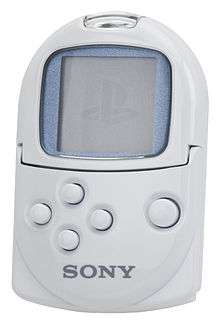PocketStation
The PocketStation is a Memory Card peripheral by Sony Computer Entertainment for the PlayStation home video game console.[3] Categorized by Sony as a combination of a Memory Card and a miniature personal digital assistant, the device features a monochrome liquid crystal display (LCD), infrared communication capability, a real-time clock, built-in flash memory, and sound capability. To use the device's memory card functionality, it must be connected to a PlayStation through a memory card slot. It was released exclusively in Japan on January 23, 1999.[2][1]
 | |
 | |
| Developer | Sony Computer Entertainment |
|---|---|
| Manufacturer | Sony Corporation |
| Type | Peripheral |
| Generation | Fifth generation era |
| Release date | |
| Lifespan | 1999–2002 |
| Discontinued |
|
| Media | PlayStation CD-ROM (used for content transfer) |
| CPU | ARM7T (32 bit RISC Processor) |
| Memory | 2 KB |
| Input |
|
| Power | 1 CR-2032 lithium battery |
| Dimensions | 64 mm (2.5 in) (h) 42 mm (1.7 in) (w) 13.5 mm (0.53 in) (d) |
| Mass | 30 grams (1.1 oz) |
| Successor | PlayStation Portable |
Software for the PocketStation was typically distributed as extras for PlayStation games, included in the CD-ROM, enhancing the games with added features. Stand-alone software could also be downloaded through the PlayStation console. The software is then transferred to the PocketStation for use. A built-in infrared data interface allows direct transfer of data such as game saves between PocketStation units, as well as multiplayer gaming.
The original Japanese ship date for the PocketStation was set for December 23, 1998, but it was delayed a full month.[1] Sony only shipped an initial 60,000 units of the peripheral when it was released on January 23, 1999.[4] It was initially available in two case colors: white and clear.[5] It proved extremely popular, selling out all over the region. Sony planned to release the PocketStation outside Japan, engaging in promotional activity in Europe and North America, but the release did not occur.[6] SCEA cited an inability meeting Japanese demand as the reason for the PocketStation's absence.[7][8] Despite this, a few games, such as Final Fantasy VIII and SaGa Frontier 2, retained PocketStation functionality in their localized versions.[9][10]
The PocketStation's most popular game was Dokodemo Issho, which sold over 1.5 million copies in Japan and is the first game to star Sony's mascot Toro.[11] The PocketStation was discontinued in July 2002 after having shipped nearly five million units.[12]
On November 5, 2013, it was announced that the PocketStation would be revived as an application for the PlayStation Vita, allowing users to play PocketStation format minigames for any classic PlayStation games that they own.[13] Originally it was only available to PlayStation Plus members, it was later released to the general public. It remains an exclusive to the Japanese PlayStation Vitas.
The PocketStation also shares similarities with Sega's VMU for the Dreamcast.
Technical specifications
- CPU: ARM7T (32-bit RISC chip)
- Memory: 2K bytes SRAM, 128K bytes Flash RAM
- Screen: 32×32 dot monochrome LCD[14]
- Sound: 1 miniature speaker (10-bit PCM)
- Switches: 5 input buttons, 1 reset button
- Infrared communication: Bi-directional (supports IrDA based and conventional remote control systems)
- LED indicator: 1 (red)
- Battery: 1 CR-2032 lithium battery
- Other functions: calendar function and identification number.
- Dimensions: 64 × 42 × 13.5 mm (height × width × depth)
- Weight: Approximately 30g (including battery)[3]
- Available colors: White, Crystal/Clear, Black (Japanese Yu-Gi-Oh! Forbidden Memories Limited Edition), Crystal/Clear Pink (Tokimeki Memorial 2 Limited Edition)
Compatible games
- All Japan Pro Wrestling[14]
- Arc the Lad III
- Armored Core: Master of Arena[14]
- Battle Bug Story[14]
- Be Pirates![14]
- Boku wa Koukuu Kanseikan
- Brightis
- Burger Burger 2[14]
- Chaos Break
- Chocobo Stallion
- Crash Bandicoot 3: Warped[14]
- Dance Dance Revolution 3rdMix
- Dance Dance Revolution 4thMix
- Dance Dance Revolution 5thMix
- Devil Summoner: Soul Hackers
- Digimon Tamers: Pocket Culumon
- Dokodemo Hamster 2
- Dokodemo Issho[14]
- Final Fantasy VIII[9]
- Fire Pro G
- Fish Hunter[14]
- Gallop Racer 3[14]
- Grandia
- Harvest Moon: Back to Nature
- Hello Kitty: White Present[14]
- Hot Shots Golf 2
- I.Q. Final[14]
- Jade Cocoon: Story of the Tamamayu[15]
- JoJo's Bizarre Adventure
- Koneko mo Issho
- Kyro-chan's Print Club[14]
- The Legend of Dragoon (Japanese version)[16]
- Legend of Mana
- Love Hina 2
- Lunatic Dawn 3[14]
- LMA Manager
- Medarot R Parts Collection[17]
- Metal Gear Solid: Integral[18]
- Mister Prospector[14]
- The Misadventures of Tron Bonne
- Monster Race[14]
- Monster Farm 2[14]
- Monster World[14]
- Paqa
- Pi to Mail[14]
- Pocket Digimon World
- Pocket Digimon World: Cool & Nature Battle Disc
- Pocket Digimon World: Wind Battle Disc
- Pocket Dungeon[14]
- Pocke-Kano Yumi
- Pocket MuuMuu[19]
- Pocket Tuner[20]
- Pocketan
- Pop'n Music 2
- Pop'n Music 3 Append Disc
- Pop'n Music 4 Append Disc
- PoPoRogue
- Prologue[14]
- Racing Lagoon
- RayCrisis (Japanese version)
- Remote Control Dandy
- R4: Ridge Racer Type 4[18]
- Rival Schools 2 (Shiritsu Justice Gakuen Nekketsu Seisyun Nikki 2)
- Rockman Complete Works[18]
- SaGa Frontier 2[10]
- Samurai Shodown : Warriors Rage 2
- Saru Get You!
- Shop Keeper[14]
- Spyro the Dragon (Japanese version)[14]
- Spyro 2: Ripto's Rage! (Japanese version)
- Street Fighter Alpha 3 (Through Gameshark code)[18]
- Street Fighter Zero 3 (Japanese version)
- Super Robot Wars Alpha
- Tales of Eternia (Japanese version)
- Theme Aquarium[14]
- Tokimeki Memorial 2
- World Neverland 2[14]
- World Stadium 3[14]
- Yu-Gi-Oh! True Duel Monsters: Sealed Memories
See also
References
- "PocketStation delayed in Japan". Computer and Video Games. Future Publishing. 1998-12-09. Retrieved 2008-08-28.
Sony has delayed the Japanese release of its PocketStation PDA from December 23 to January 23, 1999.
- "超小型PDA「PocketStation」1月23日に発売延期" (PDF) (in Japanese). Sony Computer Entertainment. December 9, 1998. p. 3. Archived from the original (PDF) on 2006-09-13. Retrieved 2007-10-30.
- プレイステーションの楽しみをさらに広げる (PDF) (in Japanese). Sony Computer Entertainment. 1998-10-08. Archived from the original (PDF) on 2009-10-10. Retrieved 2008-08-28.
- IGN staff (January 28, 1999). "PocketStation Shortages Rock Japan". IGN. Retrieved 2009-12-02.
- IGN staff (October 8, 1998). "TGS: Sony's Next Stop: Pocket Station". IGN. Retrieved 2009-12-05.
- Mark J. P. Wolf (2008). The video game explosion: a history from PONG to Playstation and beyond. ABC-CLIO. p. 148. ISBN 978-0-313-33868-7. Retrieved 16 August 2011.
- Commodore Wheeler (May 13, 1999). "Pocketstation Cancelled in the US". RPGFan. Retrieved 2009-12-02.
- IGN staff (May 13, 1999). "PocketStation Slips Indefinitely". IGN. Retrieved 2009-12-02.
- Square Electronic Arts, ed. (1999). Final Fantasy VIII North American instruction manual. Square Electronic Arts. pp. 38–40. SLUS-00892.
- Square Electronic Arts, ed. (2000). SaGa Frontier 2 North American instruction manual. Square Electronic Arts. p. 26. SLUS-00933.
- Fennec Fox (July 19, 2002). "Sony Discontinues PocketStation". GamePro. Archived from the original on 2011-06-07. Retrieved 2009-12-02.
- GameSpot staff (July 19, 2002). "Sony ceases PocketStation production". GameSpot. Archived from the original on September 8, 2012. Retrieved 2009-12-02.
- 2013-11-04, Play Chocobo World On Vita, PocketStation Is A Downloadable App In Japan, Siliconera
- "International Previews: PocketStation". Official U.S. PlayStation Magazine. 2 (7): 80–82. April 1999.
- Genki, ed. (1999). Jade Cocoon Japanese instruction manual. Genki. p. 37. SLPS-01729.
- IGN staff (November 30, 2009). "IGN: New Legend of Dragoon Info". IGN. Retrieved 2009-05-17.
- 携帯型ゲーム機コンプリートガイド [The Complete Guide to Handheld Consoles] (in Japanese). Shufu no Tomo Infos. 2013. p. 102. ISBN 978-4072879290.
- Parish, Jeremy (2006). "Forgotten Gem: Jumping Flash!". 1UP.com. Archived from the original on 2007-09-27. Retrieved 2008-11-23.
- IGN staff (January 11, 1999). "Import Watch: Pocket MuuMuu". IGN. Retrieved 2008-11-23.
- "IGN: Pocket Tuner". IGN. Retrieved 2009-05-17.
External links
- PlayStation.jp entry (in Japanese)
| Wikimedia Commons has media related to PocketStation. |
